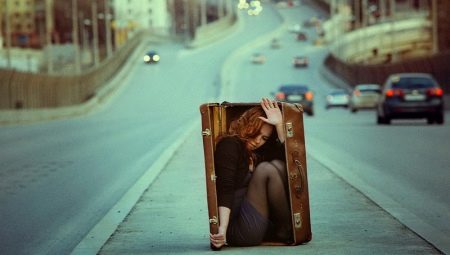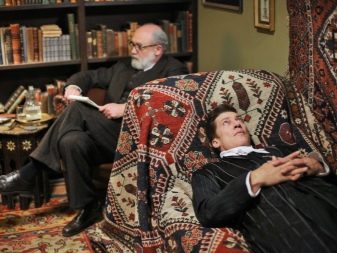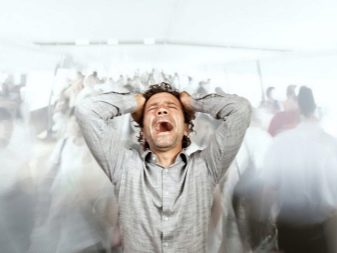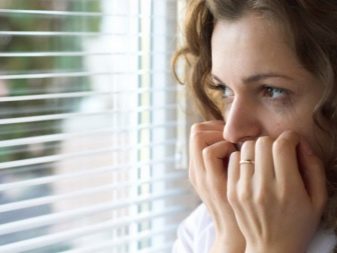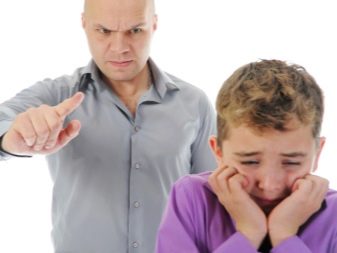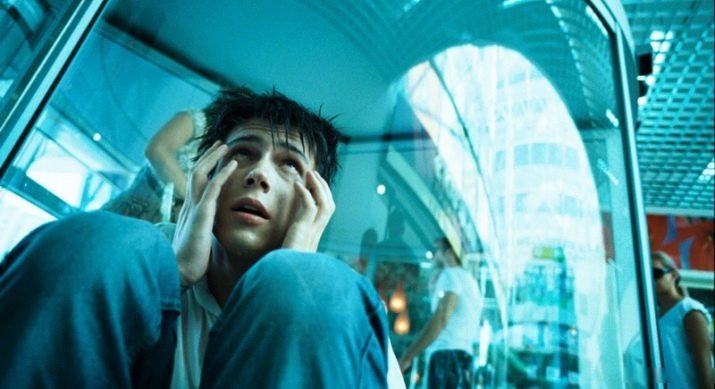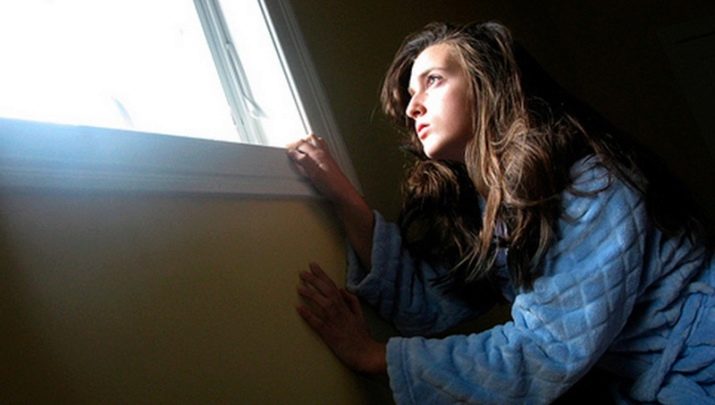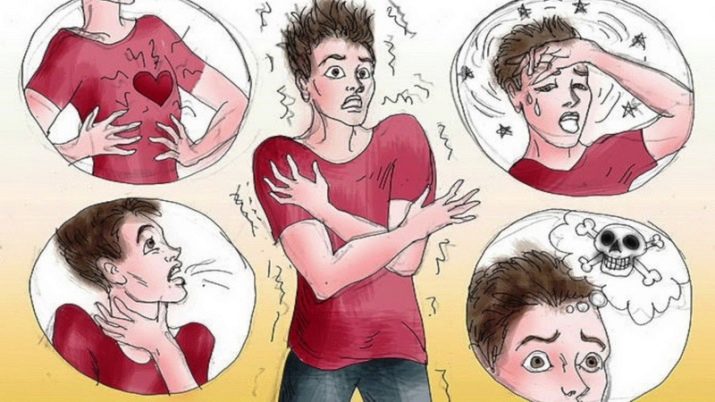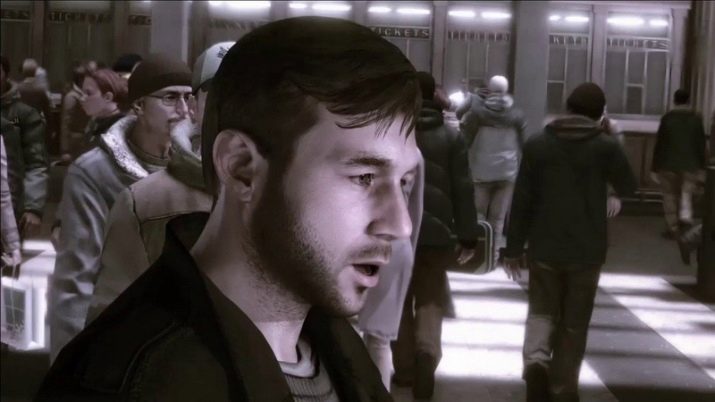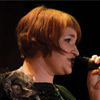Surely each of us at least once saw a man who literally runs across the square or is afraid to leave the door open. We usually consider such people to be cranks, but the problem is much deeper than it might seem at first glance.
What it is?
Agoraphobia is a multiple phobia that manifests itself in the form of fear of open spaces, large crowds. Fear of open space can manifest itself in horror of the prospect of crossing a wide street or square or leaving the door unclosed. This phobia is known for a long time. Its name comes from ancient Greek words, translated as “market” and “fear”. Therefore, the fear of open space is often called the “market disease” or “large area disease”.
Agoraphobia - a concept that includes many fears, one way or another connected with open space. Fears are unconscious and often irrational. In essence, fear is a hypertrophied manifestation of the defense mechanism - a person feels in danger, and physiological, mental and biochemical processes start in his body, which include “protection”, tell him that in this situation you need to run, to escape.
The first to describe this psychiatric disorder was the German psychiatrist and neuropathologist Karl Westphal, who lived in the 19th century. His work on “market fear” was published in 1872, and he was the first to suggest using the term “agoraphobia”. In his work, Westphal described mainly only the fear of being in an open place, but then the luminaries of science did not know about the hustle in the metro at rush hour, did not imagine large demonstrations and rallies for several hundred thousand people.
Surely many will be surprised to know that agoraphobia suffered at the time Sigmund Freud. The disease manifested itself especially strongly in his youth, and for this reason it was very difficult for a world-famous doctor to make independent walks in his old age. He himself told this to one of his students, Theodor Raik. Raik described this conversation in his writings and at the same time concluded that Freud was inspired by his own problems with the psyche to study human psychology and its deepest secrets. And, indeed, Freud succeeded a lot.
Before him, psychiatrists tried to heal fears with morphine, hypnosis, and electricity. In extreme cases, the patient was sent with phobias to the healing waters or resort. And it was Freud who first proposed to talk, talk with patients, discuss their problem in order to minimize the manifestations of agoraphobia. The best medical minds of the world were shocked by such a proposal, it did not fit into any reasonable framework, but they themselves could not offer anything better, and therefore, in many respects, Freud defined the principles of psychotherapy and fear of open spaces and large crowds.
Today, medicine looks at agoraphobia wider. It includes not only the fear of open spaces, but also the fear of similar situations (being out of the house, the need to move somewhere out of the house, being in a crowd, public places, in transport and the subway). The agoraphobia is attributed to the fear of having to walk unaccompanied along a deserted street, a park, the fear of going on a journey or traveling alone.They also include the fear of going to markets, big stores, restaurants, cinemas, going to rallies. For agoraphoba is characteristic fear of any place that he, in which case, will not be able to leave, being unnoticed, without attracting the attention of others.
At the same time, people suffering from this disorder are well aware that their fears and panic attacks have no reason and are very afraid that such attacks will occur in public, that is, they will become public. As a result, a person finds the only reasonable, in his view, way out - he closes in his “fortress” (at home) and no force can force her to leave.
On its territory, the agoraphob feels safe. Most of them can perfectly communicate, receive guests, be hospitable hosts, work, hold telephone calls, solve very complex creative tasks, but only on their own territory. As long as they understand that the space around them is under control, they behave adequately. They can live for years without leaving home. Trying to avoid panic attacks, people with this disorder consciously limit their movements, narrow the scope of activities, try to avoid any situations in which they may be too far from their safe space. It's important for them to know that if necessary, they can quickly return to it.
Quite often agoraphobia is a concomitant symptom of other disturbances of the psyche of the anxious type, panic syndrome, social phobia. Agoraphobia is called by psychiatrists one of the most difficult phobias, it often leads to disability. So, it is a mistake to consider the agoraphobes as mere eccentrics. The condition should be monitored and treated by a psychiatrist or psychotherapist.
Marilyn Monroe suffered from agoraphobia, she was very afraid of open places and large crowds of people and visited them only when accompanied by relatives or friends whom she trusted. A similar problem was with the actress Barbara Streisand.
Causes
If you ask any agoraphobe what exactly he is afraid of, why he cannot go to the middle of the square and tell everyone what he thinks about them, or just leave his apartment, he is unlikely to find the answer. In 95% of cases, patients with such a phobia consider their fears completely inexplicable. They see no connection between panic and previous shocks and psychological trauma. Only about 5% of the agoraphobes can, thinking hard, recall that for the very first time they experienced wild horror and panic in a situation when they felt bad in certain specific circumstances: had flu, tired, it was very stuffy and hot, worried before interviewing or passing test.
They, the doctor, of course, believe. But circumstances and situations in which fear arises cannot explain the reason for its appearance. And on this score, psychiatrists and neurophysiologists know what the agoraphobes themselves do not realize - the disorder is closely related to the critically low level of a person’s sense of personal security. Quite often it is laid in childhood. If a man at a tender age began to perceive himself as being vulnerable, weak and helpless, unable to resist the evil, aggressive and vile world, then the likelihood that agoraphobia will manifest itself at a later age is very high.
Why does a child feel like that? For three reasons:
- parents take care of him unnecessarily, leaving no space for their own decisions and actions, simultaneously suggesting that the world is full of nightmares and dangers, “you need to be careful and always alert”;
- parents do not pay attention to the child, are not interested in his feelings and fears, he does not feel support and safety next to adults;
- parents are too demanding, despotic, authoritarian, and the child is constantly tense in the expectation that his actions, words, deeds will cause disapproval and even punishment.
In all these situations, fear becomes a familiar companion of life from childhood, to some degree or another, it is always present. But it would be unfair to blame the parents. There are individual prerequisites for the emergence of mental anxiety disorders. Most often, agoraphobia develops in people with a certain type of nervous system — very sensitive, impressionable individuals, anxious, prone to delve into their feelings, secretive, not ready to show the world their weaknesses.
Sometimes the first attack of agoraphobia occurs after severe traumatic situations - severe illness, physical torture, sexual violence, the death of a very near and dear person, after a natural disaster, in a war zone. An adult with such a psychotype may develop an illness after losing an important job for him, his partner’s care.
But all this is only external circumstances. What happens inside a person? In fact, his own brain begins to deceive him - that is why many patients with agoraphobia develop problems with the vestibular apparatus. A healthy person manages to maintain balance due to three types of signals - proprioceptive, tactile and visual. These guidelines are quite enough to understand where you are and what is your position at the point of space in the current time.
Agoraphobes can have the perception of only two types of signals - tactile and visual. Due to this, there is a pronounced disorientation, when a person finds himself inside a swarming crowd, on inclined surfaces and large open spaces with a minimum number of visual landmarks. The brain sends them erroneous signals, resulting in possible imbalance.
note that the brain is not capable of such “tricks” by itself, but with the active support of hormones. Anxiety arises as a defense mechanism, and then stress hormones (for example, adrenaline) are immediately released into the blood. The hormone immediately causes a “run or protect” reaction in the brain.
But the world for the agoraphobe is too big and scary, and he won’t win it, and he (in his personal perception) is small and weak, and therefore the only possible reaction of the brain is a signal to run.
With some congenital and acquired pathologies associated with hormonal disorders, the development of agoraphobia may have endocrine causes (pathological processes in the brain trigger an imbalance of hormones). This is possible with neurocirculatory dystonia, alcoholism, drug addiction, gross pathologies of the thyroid gland.
It is noteworthy that big coffee lovers and everything that contains caffeine (strong tea and dark chocolate) also risk replenishing the friendly ranks of the agoraphobes - caffeine stimulates the production of stress hormones and if the predisposing factors coincide, the start of the “market disease” is quite possible. According to statistics, agoraphobia in varying degrees, occurs in 5% of the world's population, men are less susceptible to it than women are about 2 times.
Symptoms
Agoraphoba is enough to find out. He is afraid to leave the house, to do something outside his usual territory under control. Going out, crossing the road, going down the subway and getting on the crowded morning bus for the classical agoraphobe are difficult tasks, and sometimes impossible at all. In this case, one is afraid to visit the shops, and the second is not able to visit the hairdresser. Public transport is a common fear in such a disorder, because while a bus is traveling, a person cannot get up and leave it if he feels in danger.
But the agoraphob fears not so much a square, a park, an open door, or a deserted street. He is afraid of becoming ridiculous in the eyes of others, if he suddenly becomes scared, because in most cases a panic attack starts. He is afraid of "losing face", becoming the object of bullying, ridicule, because he is well aware that he hardly manages to control panic attacks.
At the same time, accompanied by relatives or someone to whom the patient fully trusts, the level of anxiety decreases, and the person is able to do something that cannot be done alone. There are agoraphobes that have only one kind of fear, for example, the fear of crossing the square on foot or the fear of getting on the bus. There are people who suffer at once with several fears at the same time up to the complete impossibility to leave their apartment, to move somewhere, and in the most difficult cases and in their own walls alone they cannot remain.
Typically, agoraphobes act proactively — plan their everyday life in such a way as not to encounter any turns of fate with situations in which they find themselves afraid to be: looking for work within walking distance, if they are afraid of transport, they start working remotely at home, if they are afraid to leave the house, order food at home, if they are afraid to go to the store, closers are put on the door, so as not to forget to close the door behind them. And in their measures they are very consistent, punctual and attentive to trifles.
If, however, the agoraphob, despite all precautions, turns out to be in alarming circumstances, the following signs of the disease can be noted:
- breathing quickens and becomes shallow, shallow;
- heartbeat quickens;
- sweating increases, face and hands sweat particularly hard;
- dizziness occurs, possible loss of orientation in space, falling;
- there is a feeling of "coma in the throat", it becomes difficult to swallow;
- there is a feeling of nausea and constriction in the stomach.
At the same time, a person is afraid that others will notice what he is experiencing now, which increases physical manifestations. Many patients at the time of the attack are afraid to lose their mind or die.
If a cautious and prudent agooraphobus knows that soon he will have to deal with a terrible, dangerous situation (for example, you really need to visit the passport office and get a document, because no one will do that for him), then he waits for fear in a few days, anxiety increases gradually.
True agoraphobes have low self-esteem, they are almost sure in advance that nothing good will come of their plots and ideas. They are afraid of loneliness, because they simply do not understand how to survive without support, care, protection from outside. They are painfully parting, they can fall into severe depression.
The whole life of agoraphoba - one incessant battle for additional safe space under the sun. And it happens that patients manage to win additional lands to their “fortress”, they expand the space in which they feel calm. But after the occurrence of unforeseen traumatic circumstances (the wife left, the husband left, the friend betrayed, was dismissed from work, was not accepted to work), the progress usually comes to naught, and the person returns to his “island of safety”.
Psychiatrists have noticed that The first signs of the disease usually occur when a person reaches the age of 20-25 years. And this is the main difference between this fear and other phobias, which usually manifest themselves in adolescence or childhood. According to the analysis of medical records of people with agoraphobia, experts noticed that the first attack of horror usually occurs in certain situations - when a person is standing at a bus stop and waiting for his tram or at the moment when he walks through a shopping center or market, choosing a purchase.
Usually the disorder has persistent chronic. Periods of exacerbations are replaced by remission, and then exacerbations occur again. Seven out of ten patients develop classical clinical depression, and almost half have phobic disorders. If a person gradually develops panic syndrome, the disease has the most severe course and is the most difficult to treat.
An appropriate diagnosis can only be made after the conclusion of a psychiatrist who will listen to complaints, compare symptoms and determine the level of anxiety with the help of a special test and a series of questionnaires (Hartman's MoI questionnaire). As a result, a certain form of the disease is established - without panic disorder or with panic disorder.
Treatment
Unfortunately, science and medicine do not know the "magic pill" that would help a person get rid of a disease like agoraphobia. Therefore, therapy will be long, complex, sometimes it continues throughout the life of agoraphoba.
Much depends on which form of the disorder is established - with or without panic disorder. If there are no panic attacks as such, it is accepted to treat the person with the help of psychotherapy. This is the most effective way today to deal with the fear of open space, a crowd or transport. The use of drugs in the case of nepanic agoraphobia was considered ineffective, pills from this disease can not be cured, you can only temporarily reduce the symptoms. But in especially persistent cases of an illness, tranquilizers are recommended at the same time with a psychotherapeutic course of treatment for short periods.
If other mental disorders are detected in the agoraphoba, their treatment occurs simultaneously with the treatment of “market fear”. Consider the basic methods that help overcome this phobia.
Psychotherapy
The main method, which is assessed today as the most effective in psychiatry and psychology, is cognitive behavioral therapy. At the very beginning, the doctor identifies the degree and frequency of anxiety and fears, the circumstances in which a person experiences them. Next, links are established with certain memories, emotions and experiences of the patient. And then the doctor begins to change with the patient the thoughts and beliefs that provoke the appearance of fear in certain circumstances.
At the second stage, when a person begins to realize the absurdity of his nightmares, they begin to gradually immerse him in situations that he had recently feared most in life. First, it happens with the help of a specialist, and then - independently. As a result, situations that were frightened recently become habitual, in fact they are not at all scary, anxiety quite naturally begins to decrease.
If agoraphobia in humans is severe, psychotherapy proceeds in the presence of medication. It can be long. Often, experts use such techniques as gestalt therapy, psychoanalysis, psychodrama, existential therapy.
The psychotherapist and the psychiatrist do not set a goal to destroy fear as such. They pursue another goal - remove those psychological attitudes and prerequisites, unhealthy perception of oneself and the world around, which lead to fear. Thus, treatment is aimed at increasing self-esteem, at establishing more friendly relations with the outside world and the people inhabiting it. Without this, the sense of psychotherapy will be at a minimum, and soon the phobia will return. In particularly difficult cases, hypnosis is used.
Medicines
For the treatment of using various drugs. They can be divided into several groups.
Restorative and dietary supplements
These include drugs that essentially do not cure, but have a restorative effect on the body. Separately can not be used because of the futility of such drugs for mental disorders. But in complex treatment can be prescribed. These include “Glycine”, “Afobazol”, “Fezam”, “Cerebrolysin”, “Magne B6”
Tranquilizers
They have mainly symptomatic effect, do not treat the root cause in principle. Cause inhibition of signals in the brain, thereby reducing anxiety. Most often used benzodiazepines "Fenazepam", "Diazepam". The drugs have side effects. with prolonged use cause drug dependence, therefore, they are not suitable for prolonged treatment.
Antidepressants
Drugs in this group are considered more effective in the treatment of agoraphobia than the agents listed above. In nearly 80% of patients, anxiety levels are reduced. Means are not addictive. The effect is achieved by normalizing the number of neurotransmitters in brain cells (increased serotonin levels in particular). The best result is achieved with simultaneous use antidepressants and psychotherapy. Often used Paroxetine, Sertralin, Fluoxetine.
General rules state that a person should take all medications, being absolutely sober and sane. That is, alcohol, coffee, drugs at the time of treatment is excluded. The patient should not exceed the dosage recommended by the doctor. Moreover, the rejection of psychotherapy does not guarantee any effect from the treatment in general. Pills themselves, if they "work", then only with respect to certain symptoms and not for long.
Projections for agoraphobia depend on how deep and severe the disorder is, as well as on the person’s personal interest in healing from a phobia. If the patient is not well motivated enough, then all the efforts of a psychiatrist or psychotherapist will go to ashes.
Self help
Independently cope with agoraphobia is almost impossible, because fear quickly becomes an integral part of a person’s life, part of his own personality. And the fight against it reminds the notorious fight of bees against honey. Therefore, an appeal to a specialist is necessary. Undergoing treatment, the following recommendations will help speed up positive results and overcome fears:
- learn to relax - practice meditation, do yoga (this can be done on video tutorials), devote relaxation time every day, better when it happens in the morning and evening;
- believe that you are on your way to recovery, you have enough strength to go all the way;
- learn breathing exercises - a series of breaths and exhalations of a certain depth and intensity helps to quickly deal with panic, if the attack recurs;
- keep a diary in which every day you specify in details what part of your fears you have already managed to win, it will help you see progress and will motivate you for further treatment.
As far as possible, try to enlist the support of a person you trust. Share with him your new sensations, achievements. But gradually gain more independence: if earlier you could not go to the store without a guide, do not be afraid to try to do it yourself, but first make half the way to the store and return, and then go all the way. In the next "approach" go to the store and stay there for a bit. Gradually succeed and make a purchase.
According to the results of recent studies, responsibility for someone who is weaker than you is very helpful in agoraphobia. And therefore, if possible, get a pet with whom you want to walk, for example, a dog. With it, you will not feel lonely on the street, and you will have to go there at least 2-3 times a day, which will gradually turn the hostile environment into a familiar one.
Prevention
Prevention of agoraphobia does not exist, since the triggers (provoking factors) are still little studied. And prevention is wiser to take care of parents who want to raise their children mentally healthy. For this, moms and dads should not adhere to an authoritarian parenting style, in which the child is constantly intimidated. Should be eliminated and overprotect - the child must have enough personal space and independence, he must have the right of choice. At first it will be a choice, what to eat for afternoon tea, and later - the choice of profession, university, friends.
If you are a sensitive person, anxious and very worried about what others think about you, if you are often afraid not to cope with the work that you have to do on your own, without the help of others, if you are extremely uncomfortable in the subway or bus (but it is not is about panic), you need to seek help from a psychologist. This will help to reconsider some beliefs that under adverse circumstances may well turn into the development of agoraphobia.
First of all, it is important to understand that you are strong enough to live in the outside world without fear. And the world itself is not as malicious and unfriendly as it seems. Try to see what is good in it, and then the street outside your window will never become a “minefield”, on which you will not agree to step for any price.
How to get rid of agoraphobia, see the next video.
